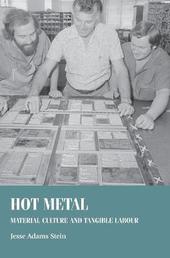
|
Hot Metal: Material Culture and Tangible Labour
Hardback
Main Details
| Title |
Hot Metal: Material Culture and Tangible Labour
|
| Authors and Contributors |
By (author) Jesse Adams Stein
|
| Series | Studies in Design and Material Culture |
|---|
| Physical Properties |
| Format:Hardback | | Pages:232 | | Dimensions(mm): Height 240,Width 170 |
|
| Category/Genre | Industrialisation and industrial history |
|---|
| ISBN/Barcode |
9781784994341
|
| Classifications | Dewey:306.4609045 |
|---|
| Audience | | Undergraduate | | Postgraduate, Research & Scholarly | |
|---|
| Illustrations |
45 black & white illustrations
|
|
Publishing Details |
| Publisher |
Manchester University Press
|
| Imprint |
Manchester University Press
|
| Publication Date |
13 October 2016 |
| Publication Country |
United Kingdom
|
Description
The world of work is tightly entwined with the world of things. Hot metal illuminates connections between design, material culture and labour between the 1960s and the 1980s, when the traditional crafts of hot-metal typesetting and letterpress were finally made obsolete with the introduction of computerised technologies. This multidisciplinary history provides an evocative rendering of design culture by exploring an intriguing case: a doggedly traditional Government Printing Office in Australia. It explores the struggles experienced by printers as they engaged in technological retraining, shortly before facing factory closure. Topics explored include spatial memory within oral history, gender-labour tensions, the rise of neoliberalism and the secret making of objects 'on the side'. This book will appeal to researchers in design and social history, labour history, material culture and gender studies. It is an accessible, richly argued text that will benefit students seeking to learn about the nature and erosion of blue-collar work and the history of printing as a craft. -- .
Author Biography
Jesse Adams Stein is Chancellor's Research Fellow in the School of Design at the University of Technology, Sydney -- .
Reviews'Jesse Adams Stein's book is a fascinating and accessible study of the declining fortunes of the Government Printing Office, located on Harris Street, Ultimo. It is greatly enriched by the oral histories of the (mostly) men and some women who found themselves in an almost Kafkaesque position, facing rapid technological change, corporatisation - which undermined traditional unionism - neo-liberalism and post-industrial capitalism in the later decades of the 20th century. Its special contribution comes from its thoughtful analysis of the role of objects in this process. 'Work', the author notes, "is inextricably bound up with a world of things, with and through which the social and gendered processes of workplace life are enacted and experienced. Understanding how we interact with and interpret design is crucial for appreciating the complexities of the labour experience, particularly at times of technological disruption." This original and cross-disciplinary book brings together design, design history, oral history, labour history, gender and material culture studies. It sheds a powerful light on the transformation and loss of blue-collar work and the demise of printing as a craft.' U: Magazine, April 2017 Edition 'It's an ambitious work. Printers, and the printing trades have been the subject of quite a lot of scholarship over a long time, which produced some truly classic works. Yet in this book the author has found a way to bring a new approach to contribute to a well ploughed field. She succeeds admirably. She takes a workplace which is a building, with a single employer, a skilled workforce, an institutional identity which extends beyond the work, and a long history, and gives us a cohesive and compelling account of working life. It is at once a study of people and their relationship to technology, and a record of a period of history that is usually treated from quite different perspectives. It shows us how labour history can lead the way that history is written. In that, it is pathbreaking and important. This a terrific story. It is a critical reflection on the mistakes of economic rationalism, and the losses from deindustrialisation without becoming only a story of loss with nostalgia for a golden era. Its findings are salutary.' Diane Kirkby, Recorder Issue 228 - March 2017 'Jesse Adams Stein combines meticulous and imaginative research with sophisticated analysis to produce a highly original, engaging and illuminating account of the final decades of an Australian state enterprise, the Government Printing Office (known as the Gov) in Sydney, Australia.' Labour History, Number 112, May 2017, Raelene Frances, Monash University 'This inventive book about new approaches to material culture and labour history is a remarkable intervention in the field of design history. It will, I am confident, incite future scholars to investigate the people, spaces and objects that define and complicate the world of work.' David Brody, Journal of Design History '...this is a fitting comprehensive record, and an exciting template for future studies in this area of technological change and material affect.' Alex Griffin, The University of Melbourne, Australia, Media International Australia 'Stein successfully uses the case study as a jumping off-point to explore much broader conceptual questions. Her creative leaps of analysis are productive and energising; they will hopefully provoke further study in the areas of material culture, design and space, and contribute to methodological approaches in oral and photographic histories.' Emma Robertson, La Trobe University, Law and History, 5:1 (2018) 'It demonstrates the powerful attachments that past workers felt for the building's internal spaces, for the revolving door of material culture items associated with printing, and the camaraderie and contestation between workers. It is a persuasive and moving study of human feelings and workplace meanings.' Dr Steve Brown, Lecturer in Archaeology (Heritage Studies), University of Sydney, Australia Oral History Australia Journal 2018 -- .
|